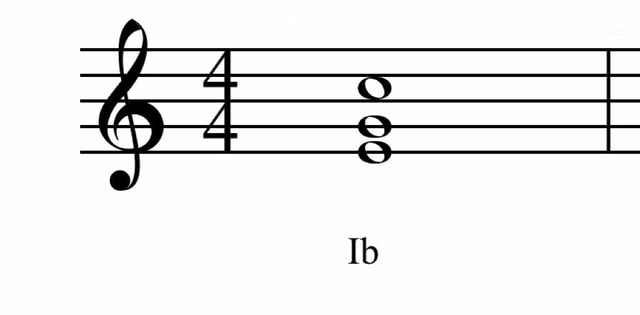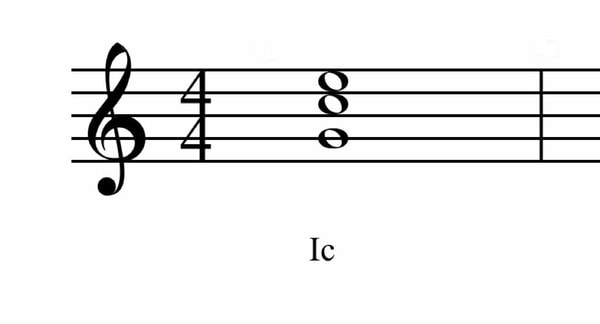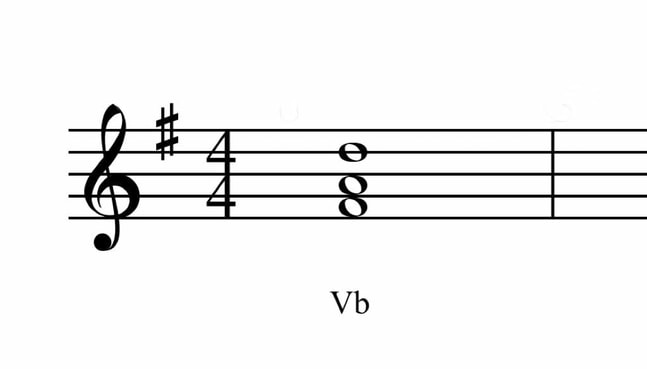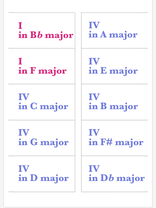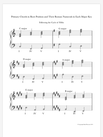In any key, you can build a triad (3 note chord) upon each degree of the scale (1 to 7), and name it after that degree of the scale, either with a Roman numeral, or the full name:
E.g. for the key of C major, you can build a chord upon the first degree of the scale by using the first degree of the scale as the root of the chord, and adding a note a 3rd above the root, and another one a 5th above the root. (See this explanation about intervals if you’re not sure what a 3rd or 5th is). So, the triad that is built upon the first degree of the scale in C major is: C, E and G. We call this chord the tonic triad in the key of C, or we give it the Roman numeral: I.
In the same way, we can build a chord upon the 5th degree of the scale of C major, and we end up with G, B and D. We call this chord the dominant triad in the key of C, or give it the Roman numeral: V.
Below are pictures showing all the chords in each major key, with their Roman numerals and names.
- I or tonic.
- II or supertonic.
- III or mediant.
- IV or subdominant.
- V or dominant.
- VI or submediant.
- VII or leading note.
E.g. for the key of C major, you can build a chord upon the first degree of the scale by using the first degree of the scale as the root of the chord, and adding a note a 3rd above the root, and another one a 5th above the root. (See this explanation about intervals if you’re not sure what a 3rd or 5th is). So, the triad that is built upon the first degree of the scale in C major is: C, E and G. We call this chord the tonic triad in the key of C, or we give it the Roman numeral: I.
In the same way, we can build a chord upon the 5th degree of the scale of C major, and we end up with G, B and D. We call this chord the dominant triad in the key of C, or give it the Roman numeral: V.
Below are pictures showing all the chords in each major key, with their Roman numerals and names.
Each of the chords above are in root position. This means that the root of the chord is in the bass. When you change the order of the notes of the chord, the chord is in an inversion.
If you put the 2nd note of the chord in the bass (the note that is a 3rd above the root), it is in first inversion. See the example below. It is the tonic triad of C major in first inversion. When a chord is in first inversion, we add “b” to the Roman numeral. (An “a” can be added to indicate that a chord is in root position; e.g. Ia, IVa, or Va; but generally the Roman numeral is used alone to indicate that it is in root position.)
If you put the 2nd note of the chord in the bass (the note that is a 3rd above the root), it is in first inversion. See the example below. It is the tonic triad of C major in first inversion. When a chord is in first inversion, we add “b” to the Roman numeral. (An “a” can be added to indicate that a chord is in root position; e.g. Ia, IVa, or Va; but generally the Roman numeral is used alone to indicate that it is in root position.)
If you put the third note of the chord in the bass (the note that is a 5th above the root), it is in second inversion. The example below shows the tonic triad of C major in second inversion. We put a “c” next to the Roman numeral to indicate that a chord is in 2nd inversion.
You can do the same with any of the chords listed above, i.e. change which note is in the bass, resulting in a different inversion. E.g. have a look at the chords in G major. The chord on the fifth degree of the scale (the dominant, or chord V) is D, F sharp and A. When the D is in the bass, the chord is in root position. If we were to rearrange these notes and put F sharp in the bass (so we end up with F sharp, A, D) the chord would be in first inversion. It would be the dominant chord of G major in first inversion. See the picture below:
Flash cards are an effective way to learn and remember chords and other music theory concepts. Try my free flash cards for learning the primary chords (I, IV, V) in every major key:
Answers:












